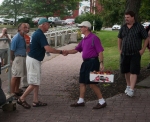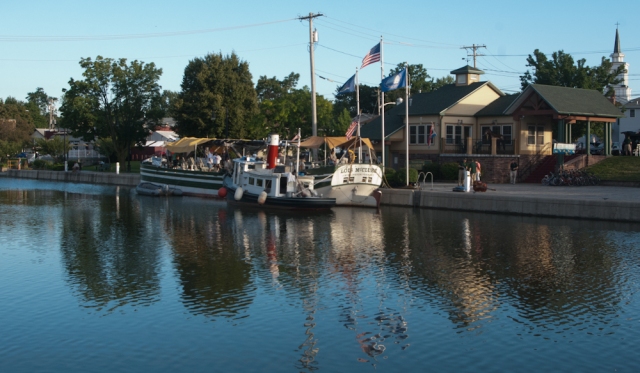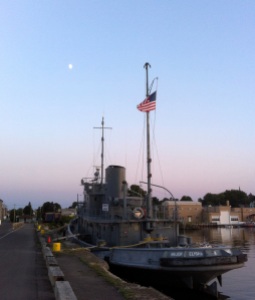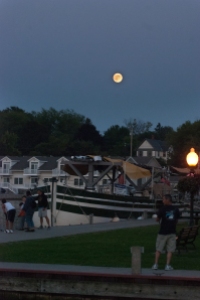When the tug C. L. Churchill moved the Lake Champlain canal schooner Lois McClure out into the outer harbor at Buffalo on August 6th, the scene couldn’t have been more of a contrast to that when the vessels entered on the 2nd: instead of swells heaving in from Lake Erie through the gap in the breakwall, the water was as smooth as a mirror. The trip down the Niagara River toTonawanda was swift and uneventful.
After arrival, we discovered a nearby pump-out facility, and, to take advantage of it, had to turn the schooner round in the fairly narrow Tonawanda Creek, go back to the sanitary pump, and turn her again, to tie up within reach of its hose. There was heavy traffic in the creek, a parade of motor cruisers in both directions, as well as a number of folks out taking the air in rented kayaks and pedal boats, some, apparently, on their first voyage. No matter. Our two 180-degree turns were made in slow motion, and the fleets made their way cautiously through the narrow gaps left by our bow and stern with casual unconcern. Now, we were the obstacle course.
Next day, we received almost 500 Tonawandans and North Tonawandans on board. We like to think that we present to the folks of these lively, rival towns an opportunity for relaxed comingling in neutral territory. Peace reigned, and many a canal story was exchanged.
On August 8th, we headed back east on the Erie Canal. “Clinton’s Ditch,” some had dubbed it. Without New York Governor DeWitt Clinton’s persistent faith in the idea of the waterway, it wouldn’t have been dug, at least not by 1825. The concept of connecting Lake Erie with the Hudson River elicited many reactions. Some foresaw accurately the huge potential for making money; some believed the canal would never be completed and would never be used if it was completed; some, foreshadowing Kipling, simply feared the changes that would be inevitable if east and west did meet.
On board the Lois McClure, we are privileged to immerse ourselves in both such historical musings and in the practical aspects of “if you’ve ever navigated on the Erie Canal.” We experienced one such practical aspect on the run from Tonawanda to Medina on August 8th.
We were approaching Lock 35 at Lockport, to go down through the deepest lock on the canal. When we checked in by radio with the lock keeper, he told us that he would be bringing a tour boat up in the lock before we could go down. We’d have to wait a few minutes. Fine, but I misjudged the amount of current that would send us toward the lock when the keeper filled it. The deep lock required plenty of water, and it appeared that we would sweep down on its gate before the lock was full. So, we backed into the current, but a cross wind gradually shoved us over to the right bank. Luckily, that bank was steep rock protected by thick bushes. We hove to in the bushes. The shrubbery, tangled in our awning poles, just held us against the current and kept us off the cliff. All we had to do, as we went into the lock after the tour boat went by, was sweep the deck clear of twigs and leaves. Who wouldn’t sell his farm and go to sea?

Art Cohn giving a quick bit of information to a passing tour at E35 as the LOIS locks through (photo: Tom Larsen)
Our reward for navigating to Medina was to have on board more than 200 visitors in the late afternoon and early evening. We had a fine day combining navigating on the Erie Canal with talking up its history. And, next day, repeated the pleasure, with a quiet trip to Brockport, where we colloquized with another 200 canalers.
The schooner arrived at Palmyra on August 10th. Our good friends, Steve (the fenderman) and Bonnie Hays, always take good care of us in Palmyra. They not only spread the word of our arrival according to the revised (by flood damage to the canal) schedule we were on so that 200 souls came on board next day, but also fed the crew two dinners at the Coverlet Museum. Art Cohn, the master diver and innovative nautical archaeologist, responded with a fine slide show and lecture on the discovery, cultural use, and management of shipwrecks. (Occasionally, we have to sing for our supper. On August 2nd, when we reached Lake Erie at Buffalo, I had talked to the crew about my distant relative, Oliver Hazard Perry, with emphasis on his role at the Battle of Lake Erie, where he was able to write (for some reason, all these famous words seem to end up on the backs of old envelopes), “We have met the enemy and they are ours.”)
On August 11, Isaac Parker had to leave the crew to go back to school. We had already lost Carolyn Kennedy to academia on the 3rd. These two young shipmates had made a huge difference to our crew. Their enthusiasm, good spirits, and boundless energy (and they are both wicked smart) had given all of us, and me, in particular, as an ancient mariner, an enormous lift. Carolyn is starting a doctorate program in nautical archaeology at Texas A and M; Isaac is combining his senior year of high school with mostly college courses and will be applying to the Webb Institute, one of the country’s top schools for naval architecture and engineering. We miss them both and wish them all success.
On August 12th, we had a double-take arrival at Lyons. We came out of Lock 27, and I somehow failed to recognize that our mooring wall was not just around the corner, but rather (oh no!) right here. As we swung past, first mate Tom Larsen radioed calmly from the bow, “Roger, I think this is our berth.” Yes, it certainly was.
“Art, (at the wheel of the tug) Slow to idling speed.”
“Art, Neutral.”
“Art, Slow astern.
The Oocher had come back onto the schooner’s bow after exiting the lock, so orders to Kerry Batdorf, controlling her outboard motor, to “Give a pull,” or “Give a push,” could help keep things lined up as we gradually stopped, and then backed up, and eased alongside where we were supposed to be. Mercy. How embarrassing. Our rule on board is to keep smiling no matter what in hopes people will think some of our crazy maneuvers are intentional.
Jack McCranels came on board in Lyons. When we called at Lyons in 2007, Jack gave us a wooden shipping box for five 210-ounce bottles of oleum menthae piperitae (peppermint oil) manufactured by the H. G. Hotchkiss Co. in Lyons. We display the box in the schooner’s cargo hold to illustrate a sample cargo. It provides my favorite historic example of the economic effect of the Erie Canal on a canal town like Lyons. The box proclaims that its contents won a “First Prize Medal at the Great Paris Exposition of 1867.” Before the Erie Canal, it would have been ludicrous to imagine the Hotchkiss Co. reaching, with its peppermint oil, a market more than a few miles from Lyons. There could have been no Hotchkiss Co. But with the Erie Canal, H. G. Hotchkiss could suddenly ship his product by water for ten percent of the cost of shipping by corduroy road. Nor would his bottles risk being broken en route. The Erie Canal opened to a business in Lyons, New York, the markets of the world. Hotchkiss and Lyons could prosper. Multiply that sort of prosperity by many thousands and you get fast-growing towns and cities all along the canal. And a chef in Paris could add to his cuisine the finest of Lyons, New York, peppermint oils.
The trip from Lyons to Baldwinsville took two days, with an overnight stop at Weedsport, where Art Cohn, our fearless leader (without whom, it can truly be said, there would be no replica canal schooner) treated the crew to dinner at Devaney’s Riverside Grille, a stone’s throw from the McClure. The schooner’s crew works hard and plays hard, too, if you measure playing by the decibels of laughter. InBaldwinsville, we again shared our two-way history lessons with 200 learner-teachers.
At 10:30 a.m. on August 15th, the Lois McClurewas at Three Rivers. As we left the Seneca River to enter the Oswego River, we passed the west end of the Oneida River. This part of New York State is well served by natural waterways, made navigable by “canalization,” with locks, dredging, and channel markers. In another half hour, our docklines were being caught and belayed by the Bridgehouse Brats of Phoenix. This decidedly unbratty group of youngsters is a pure delight to anyone visiting Phoenix in a boat. They will do anything for you: help you tie up or cast off, run errands, help clean your boat (!), and bring you your morning coffee.
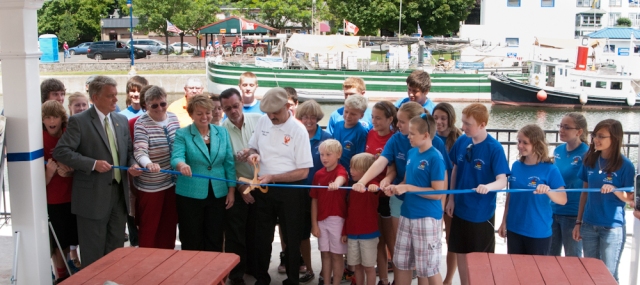
Mayor Tony Fratto, Canal Corps Director Brian Stratton, Senator Pattie Richie and the Bridgehouse Brats cutting the ribbon to open a new pavilion on the Phoenix waterfront (photo: Tom Larsen)
We participated in a ribbon-cutting ceremony for a restored pavilion on the Phoenix waterfront (it didn’t actually rise from ashes, just needed rebuilding), and, as well as hearing remarks from dignitaries like Brian Stratton, Director of the New York Canal Corporation, we heard well-deserved praises lavished on twenty-six of the Brats. And then the whole crowd came on board the Lois McClure to experience actually standing on the deck and exploring the cargo hold and cabin of a sailing canal boat of 1862.
On August 16th, we towed down the pretty Oswego River on a gorgeous day and moored to the big pier in Oswego Harbor, on Lake Ontario. On the pier is the H. Lee White Marine Museum. An adjunct of the museum, tied up just ahead of the schooner, is the ex-Army tug,Major Elisha K. Henson (USAT LT-5). Without any disloyalty to our game little C. L. Churchill, we sometimes drool over towboats that we see along the way. We’ll pass a handsome 70-footer and say, “Wow! Wouldn’t she be fun to run.” But the 110-foot, all-grayHenson, with her service ribbons for action off the Normandy beaches in World War II, is really special, the queen of the tugboat fleet that we see.
A big freighter came in off the Lake fifteen minutes before we got underway on August 18th for the run toSackets Harbor. You recognize a scale of inertia wholly different from that of the McClure when you watch a large ship dock. We try to make slow approaches to docks and locks with the schooner, but this vessel, with no assist tug, really had to creep in alongside.
Sackets Harbor is 35 miles from Oswego, across the southeast corner of Lake Ontario. The trip is like being in open ocean, no place for a flat-bottomed canal boat, if there’s much wind. We needed a calm day to make the crossing. Well, luckily, the 18th, the first of the two possible days we had allotted for the journey, was about as calm a day as you’d ever find on Lake Ontario. After seven hours of smooth towing on the hawser, we moored in the well-protected cove where the Americans had raced to build warships in the War of 1812.
The next day Ship’s Carpenter Kerry Batdorf fastened a plywood patch (an advantage of a flat-sided canal boat) over a spot at the waterline in the schooner’s planking that had been damaged by last winter’s ice in Burlington harbor. There was no leakage; this was a belt-and-suspenders repair. This schooner (knock on her wood) has never leaked; we claim that since she was built carefully of seasoned woods, instead of being quickly constructed of what was on hand, as were the canal boats of the 19th century, she is the best-built canal boat that has ever existed.
Sackets Harbor is a lively place in summer. The Lois McClure attracted nearly 500 visitors on August 20th, many of them, surely, “from away.”
The St. Lawrence River, forming the boundary between New York and Ontario, drains Lake Ontario from a point (actually the source of the river is spread along the lake shore for a dozen miles) north of Sackets Harbor. Our next port-of-call was Cape Vincent, the first town down the river on the New York side. Although we would be going alongshore, rather than out in open water, we would still be exposed to the full fetch of the lake if the wind was in the west quadrant. Sure enough, the forecast for the 21st was for a southwest breeze, increasing during the day from 10 knots to as much as 20 knots. But an early start ought to get us off the lake and into the river by noon, before things got too rough-and-tumble out there.
And it did, although there was enough swell starting to build to make both tug and schooner take some pretty good rolls, as we towed on the long hawser. Jean Belisle, our Canadian volunteer, shot a video from the stern deck of the Churchill that I believe is more conducive to seasickness than was the actual motion.
And so, we have entered the upper St. Lawrence River, new waters for the Lois McClure. We are about to go down through The Thousand Islands; we will be navigating among the ocean freighters of the St. Lawrence Seaway; and we will be calling at new ports and meeting citizens on both the U. S. and Canadian sides of the stream.
Roger Taylor
Captain


